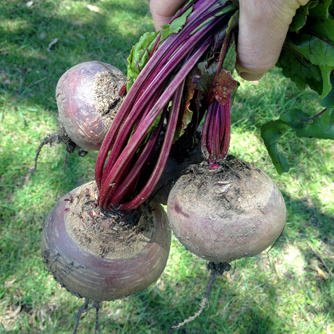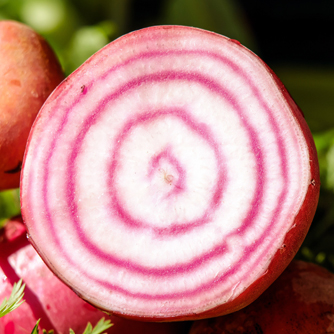Beetroot
BackBeetroot is a hardy root vegetable which contains high levels of anti-oxidants and is enjoying increasing popularity again because they’re easy to grow and taste great. Try them grated raw in salads, steamed, pickled in vinegar or baked (yummo!). The young leaves can be added fresh to salads or older leaves cooked and eaten like spinach.
There are some unusual varieties of beetroot if you look around. White, golden (which turn yellow when cooked) and miniature varieties which are great for pots. And then there’s the Italian variety Chioggia, or Bulls eye, which has alternate rings of red and white. Looks amazing when cut in half.
How To Grow Beetroot
Beetroot is frost tolerant and very versatile being able to handle some shade but does better in full sun. Prepare your soil with an organic fertiliser/manure/compost, then add an application of dolomite or lime before planting for better yields.
Each ‘seed’ is actually a cluster of several seeds surrounded by corky tissue. This corky material slows moisture absorption and can delay germination. Soak seed clusters overnight in warm water to overcome this problem. Sow seed directly into the soil and keep moist. Several seedlings will emerge from each seed cluster 8-10 days later and should be thinned to just one plant. Plant another lot of seed 2 weeks later for an extended crop.

Freshly harvested beetroot
Seedlings are also available in punnets but need to be small and fresh to minimise the risk of root damage.
Beetroot can be easily grown in pots as they don’t take up much room. Try growing the miniature varieties or just harvest regular varieties early to produce sweet baby beets.
Keep soils moist with regular even watering as drying out can result in woody root tissue developing which isn’t very tasty.
Beetroot plants will sometimes push themselves up out of the ground exposing the root. If the plants become unstable then mound some soil around them otherwise just let them be.
Sowing Guide for Beetroot
| Growing Zone | Sowing Time |
| Cool Zones | Spring, Summer |
| Mediterranean Zones | Autumn, Winter, Spring |
| Warm & Temperate Frost Free Zones | Autumn, Winter, Spring, Summer |
| Tropical & Subtropical Zones | Autumn, Winter, Spring |
Please note that beetroot will sometimes bolt to seed because of temperature and day length changes. If this occurs then try sowing seeds earlier or later to avoid the problem repeating.

Beetroot all washed and looking lovely!
Fertilising Beetroot
Plants respond well to fortnightly waterings of OCP eco-seaweed and OCP eco-aminogro mixed together. With this recipe you’ll be pulling up a bumper crop in no time! Faster growing times also make for sweeter beets.
Harvesting Beetroot
Allow about 10 weeks to harvest although it is entirely up to your personal taste and patience To check, move the soil away from the top of the root to see if it’s large enough to harvest. Generally the earlier they are harvested, the sweeter they are.
Dig the beetroot up using a fork or trowel, gently shake the soil off the root and voila!
Pests and Diseases for Beetroot
Beetroots are relatively trouble free which is another reason why they are so popular to grow. Uneven colouring and woodiness is probably the biggest complaint due to irregular watering and lack of nutrients.
Protect emerging seedlings from snails and slugs with OCP eco-shield.
Leaf diseases, like rust and various leaf spots, sometimes appear and can often be dealt with by simply removing infected leaves at the first sign of a problem. Foliar sprays of OCP eco-seaweed and OCP eco-aminogro are a useful way to keep the leaves strong and healthy whilst encourage root development at the same time. If problems persist then spray with an organic fungicide.
Nematodes can infest roots causing poor growth and distorted roots Treat the soil with OCP eco-nemguard at planting time to control nematodes and give healthy roots a change to develop. Reapply at 4-6 weekly intervals. Practice crop rotation which will also help keep nematode numbers down.

The Chioggia beetroot with it's distinctive 'bullseye stripes'


